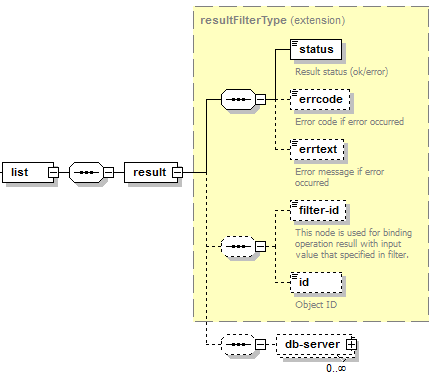This is documentation for Plesk Onyx.
Go to documentation for the latest version, Plesk Obsidian.
Retrieving the List of Available Database Servers
The list operation is used to retrieve the list of database servers available to the plan subscribers.
Request Packet Structure
A request XML packet retrieving the list of databases available to the plan subscribers includes the list operation node:
<packet>
<service-plan>
<db-servers>
<list>
...
</list>
</db-servers>
</service-plan>
</packet>
The list node is presented by a complex type
(domain_template.xsd). Its graphical representation is as follows:

- The filter node is required. It serves to specify the criteria
by which the necessary service plans will be selected from the
database. Data type: DomainTemplateFilterType
(
domain_template.xsd). See the Available Filters section for details on this node.
Response Packet Structure
The list node of the output XML packet is of complex type
(domain_template.xsd) which has the following presentation:

- The result node is required. It wraps the response got from the
server. Data type: resultFilterType (
common.xsd). - The status node is required. Specifies the execution status of the operation. Data type: string. Allowed values: ok | error.
- The errcode node is optional. Returns the error code when the operation fails. Data type: unsignedInt.
- The errtext node is optional. Returns the error message if the operation fails. Data type: string.
- The filter-id node is optional. Returns the parameter by which the service plan was filtered by in the request packet. Data type: anySimple.
- The id node is optional. Returns the identifier of the service
plan to which the application was added. Data type: id_type
(
common.xsd). - The db-server node is optional. Returns the information about
database servers available to the plan subscribers. Data type:
dbServerOutput (
domain_template.xsd).
Samples
The following request retrieves the list of database servers available in the service plan with id 1:
<packet>
<service-plan>
<db-servers>
<list>
<filter>
<id>1</id>
</filter>
</list>
</db-servers>
</service-plan>
</packet>
A positive response got from the server after retrieving the list of database servers available to plan subscribers can look as follows:
<packet>
<service-plan>
<db-servers>
<list>
<result>
<status>ok</status>
<filter-id>1</filter-id>
<id>1</id>
<db-server>
<type>mysql</type>
<id>1</id>
<host>localhost</host>
<port>3306</port>
</db-server>
<db-server>
<type>postgresql</type>
<id>2</id>
<host>localhost</host>
<port>5432</port>
</db-server>
</result>
</list>
</db-servers>
</service-plan>
</packet>